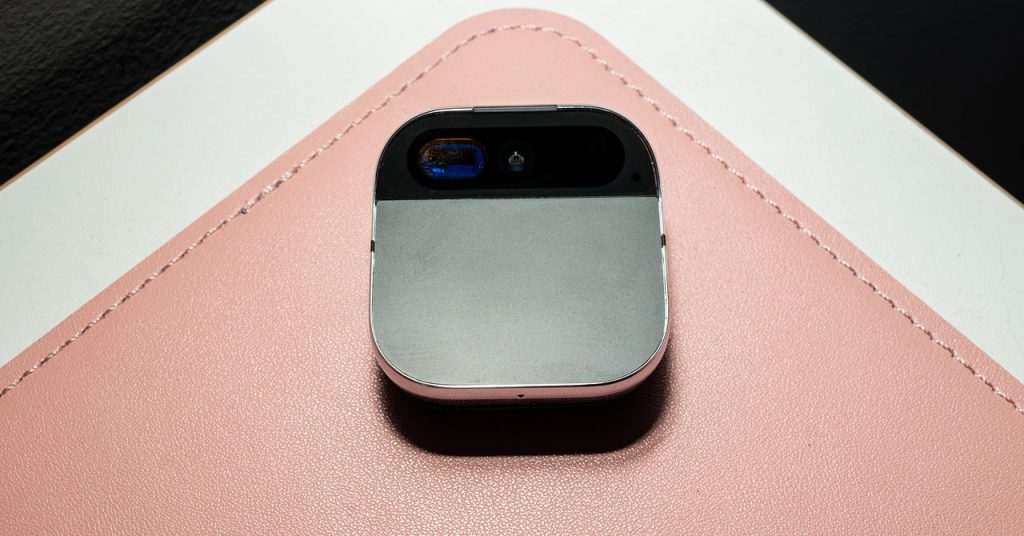The Humane Ai Pin Will Become E-Waste Next Week – WIRED

If you buy something using links in our stories, we may earn a commission. This helps support our journalism. Learn more. Please also consider subscribing to WIREDThe story of the infamous Humane Ai Pin is coming to an end. This week, the company announced that HP—known for its computers and printers that always seem to need a refill—will acquire several assets from Humane in a $116 million deal expected to close at the end of the month.HP will get more than 300 patents and patent applications, a few Humane employees—including founders Imran Chaudhri and Bethany Bongiorno—and Humane’s Cosmos operating system. Late in 2024, Humane looked to license this operating system so that third parties could inject the AI voice assistant into other products, like cars. However, nothing materialized.Humane became Silicon Valley’s “next big thing” in late 2023 when it unveiled its AI wearable, equipped with a ChatGPT-powered assistant and a laser-projected display, that promised to replace your smartphone. But when reviews arrived at launch in 2024—you can read ours here—it was panned. The issues were seemingly endless: It frequently overheated; the AI hallucinated often; there were hardly any useful features; the projector was annoying … and so on.Unsurprisingly, HP doesn’t want to do much with the Ai Pin hardware. Sales have effectively stopped, and Humane will issue refunds to anyone who bought a pin after November 15, 2024 (if you did, why?). Existing Ai Pins will cease to function after noon Pacific on February 28. Almost every core feature will stop working—but you can still find out how much battery is left!—and your data will be deleted, so make sure you sync and download it now.As for HP, it plans to integrate Humane’s Cosmos AI into its products to “unlock new levels of functionality for our customers and deliver on the promises of AI.” Good luck with that. In the meantime, Humane engineers will form a group called HP IQ, an innovation lab that will apparently build an ecosystem of smart features throughout HP’s line of products. Maybe that’ll mean a printer that will finally not drive its user crazy? Fingers crossed.All the top gear news of the week in one place. Here’s more you may have missed this week:Apple announced this week that Apple Intelligence will be coming to its Vision Pro headset as a part of visionOS 2.4, though the update is expected to roll out in April. It doesn’t just bring the suite of artificial intelligence features—like ChatGPT-powered writing assistance, Genmoji, and Image Playground—it claims to greatly improve the guest experience on Vision Pro.Currently, if you want to let someone try the Vision Pro, the owner has to wear it first to authenticate and unlock the headset, and then enable Guest Mode. Running visionOS 2.4, guests can wear the headset, and owners will receive a notification on their iPhone or iPad (which needs to be nearby) to allow access. AVP owners can also now choose what apps guests can see, and guests can save their eye and hand setup for up to 30 days so they won’t have to run through the tutorial and setup of the headset every time.A new app—Spatial Gallery—is also bundled into visionOS 2.4. Curated by Apple, it will feature spatial videos, photos, and panoramas designed to be viewed on the headset. Apple says you can expect new content regularly from photographers, brands, and behind-the-scenes moments from Apple Originals like Severance.There are several other minor features in visionOS 2.4, but one notable addition is tied to the rollout of iOS 18.4. In April, Apple Vision Pro owners will magically find a new app on their iPhone running iOS 18.4 (it will also be available to download for everyone else). The app is called Apple Vision Pro, and it’s designed to let you discover new content to enjoy on the Vision Pro, allowing you to queue up a movie or remotely download an app so that you don’t need to spend extra time in that headset you dropped $3,500 on. The app will also feature tips and headset software information, too.On a related note about Apple Intelligence, Apple confirmed this week that Visual Intelligence (which lets you use the iPhone 16 camera with a ChatGPT-powered Siri to identify and learn more about objects around you) will come to the iPhone 15 Pro models in a software update. This comes after the announcement of the iPhone 16e, where Visual Intelligence is baked into the Action Button. iPhone 15 Pro users can trigger it via the Action Button or the Control Center.Every new version of Wi-Fi brings faster speeds, better security, and enhanced stability. The first wave of routers is always super expensive, and there’s little point in updating until you have devices that support the new standard. But now that the latest phones and laptops support Wi-Fi 7, companies like Eero are introducing reasonably priced Wi-Fi 7 mesh routers. Say hello to the Eero 7 and Eero Pro 7, announced this week and shipping on February 26.Building out its Wi-Fi 7 range, the Eero 7 is the dual-band (2.4-GHz and 5-GHz) entry-level option, which promises wireless speeds up to 1.8 Gbps and two 2.5 Gbps Ethernet ports on each router. An Eero 7 two-pack can cover up to 4,000 square feet, and, though it lacks the speedy 6-GHz band, it does offer all the other goodies Wi-Fi 7 has in store, including enhanced WPA3 security, Multi-Link Operation (MLO) to connect on multiple bands and channels simultaneously, Orthogonal Frequency Division Multiple Access (OFDMA) for more connected devices, and 4K-QAM to pack more data into each signal.The Eero Pro 7 is the Goldilocks mesh that will be right for most folks. This tri-band middle child adds the 6-GHz band for rapid and stable short-range Wi-Fi. Each unit has two 5-Gbps Ethernet ports and can hit wireless speeds of 3.9 Gbps, making it a solid choice for folks with multi-gig internet connections. Each Eero Pro 7 router can handle 200 devices and covers around 2,000 square feet.Eero’s routers are fully backward compatible with earlier Eero systems and Wi-Fi versions. That means you can snag a single Eero Pro 7 to mix and match with your existing Eero mesh. Both systems double as smart home hubs with Matter, Thread, and Zigbee support. For an extra $10 a month, or $100 a year, you can add Eero Plus for parental controls, internet backup, advanced security, ad-blocking, and third-party services (password manager, VPN, and antivirus).You can preorder the Eero Pro 7 today for $300 (one-pack), $550 (two-pack), or $700 (three-pack), and they ship next week. For more modest needs, the Eero 7 is $170 (one-pack), $280 (two-pack), or $350 (three-pack). —Simon HillThe race to slim down folding phones continues with Oppo’s Find N5 the latest to claim the thinnest title at just 8.93 mm when closed (4.2 mm when open), narrowly beating the Honor Magic V3, which sits at 9.2 mm. The Oppo Find N5 is very lightweight too at 229 grams, with a flat frame that makes it easy to handle, and a smooth hinge that feels durable. It has an IPX9 and IPX8 rating for water resistance, meaning it can withstand submersion or jets of water. Great news if you like to shower with your phone.There’s a 6.62-inch cover display, and the Find N5 opens to reveal a tablet-sized 8.12-inch inner screen. Yes, you can see the crease, but it’s relatively subtle. Both displays are sharp, support up to 120-Hz refresh rate, and can peak at 2,000 nits brightness for HDR content. The slim dual-cell silicon-carbon batteries inside are rated at 5,600 mAh, enough to see you through a busy day with change. Oppo’s proprietary charging standards allow 80-watt wired charging or 50-watt wireless charging with the right accessories. You’ll find a Qualcomm Snapdragon 8 Elite chipset inside, and my review unit has a generous 16 GB of RAM and 512 GB of storage.There’s a triple-lens main camera in the Find N5, combining a 50-megapixel shooter with a large aperture and sensor for better low-light performance, a 50-megapixel periscope telephoto lens enabling 3X optical zoom, and an 8-MP ultrawide. Cutouts at the top right of the inner display and the top center of the outer display house basic 8-megapixel cameras for selfies and video calls.It wouldn’t be a new phone launch without a mention of AI, and these include AI-assisted call summaries, dual-screen translation, and photo-editing tools. What stands out is O+ Connect, Oppo’s software bridge for Apple’s macOS, allowing Oppo owners to access their MacBook remotely, drag and drop files from the Find N5 to the laptop or vice versa, and even mirror the desktop to transform a folded Find N5 into a mini MacBook.The Oppo Find N5 is available in Singapore now for $2,499 SGD (around $1,867), and will be coming to the UK and Europe soon, but not the US. Oppo hardware sometimes gets rebadged by OnePlus for the US—both are owned by the same parent company—but OnePlus has already confirmed it won’t release a folding phone in 2025. That’s a real shame for Americans, as this is one of the best folding phones we’ve seen. —Simon HillIt might sound like Eufy is foraying into the world of psychics and palm reading, but it’s not as magical as that. The company just announced a new smart lock—the FamiLock S3 Max—that uses palm-vein recognition technology as a form of biometric reading to unlock your front door.The palm reading is touch-free, unlike locks that use fingerprint scanners. It uses an infrared sensor to scan and recognize each person’s unique vein signature. Eufy claims it works quickly and is user-friendly for all ages, allowing older family members and kids to wave their hands in front of the lock and get inside.The FamiLock has an integrated doorbell and camera with a 150-degree vertical head-to-toe view and a 180-degree diagonal view, letting it double as a video doorbell that will alert you about package deliveries and movement. You can also add an internal video screen to see through the camera on the inside, like a digital peephole. It sounds a little redundant if you have an actual peephole, but it might be better for kids or folks not tall enough to check the peephole to see if it’s someone they know at the door.Other features include a door sensor, dual power supply, and compatibility with several smart home platforms and Matter. You can reserve it now for $1 and get a discount, but the FamiLock officially launches on March 17. It starts at $349, though the screen add-on brings the total to $399. —Nena FarrellDacia? Yes Dacia (or “Dah-chee-ah”), the Romanian automaker part of the Renault Group, known for cheap and cheerful cars at surprisingly good value. It’s enjoying something of a purple patch right now in Europe, thanks to a remarkably effective redesign of its well-reviewed Duster small SUV, as well as the just-launched larger version, the Bigster. Dacia already has a staggeringly cheap EV on the market, the Spring—we tried it and were won over by its diminutive charms—but it appears this is not good enough for Renault Group CEO Luca de Meo.While announcing the Renault Group’s financial performance in 2024 this week, de Meo let slip that the as-yet-unnamed new city Dacia will be priced at less than $19,000. What’s more, the turnaround for this city EV will be fast—developed and ready for production in just 16 months. “I defy any competitor in the world to do that,” de Meo said, “including the Chinese when they come to Europe.”The new model, which Dacia says will only use 750 parts (!!) to keep costs down, likely won’t replace the Spring, as that itself is relatively new. However, the Spring is built in China and will therefore be subject to any tariffs on Chinese EVs, If this new model is EU-made, then it would circumvent such tariffs, and it could also probably improve on the Spring’s 140-mile range. —Jeremy WhiteGimbals aren’t often talked about enough, but they can be vital in delivering stable video footage, whether you’re shooting on your smartphone or a professional camera. DJI this week unveiled two gimbals, designed for both of those respective platforms. The Osmo Mobile 7P and Osmo Mobile 7 are meant for smartphones, whereas the RS 4 Mini can be used with cameras and smartphones.The Osmo Mobile 7P now comes with a Multifunctional Module, an attachment that adds capabilities like enabling subject tracking with a hand gesture. While the Mobile 7 supports the module, you have to buy it separately if you want it. Since it’s not included, it’s much more lightweight at 300 grams and is cheaper. The Mobile 7P costs $149 and the Mobile 7 is $89, and both are available for purchase now.The DJI RS 4 Mini is in a different class altogether, with a starting price of $369. DJI promises speedier setups with this gimbal, including a faster way to switch to filming vertically. The stabilization has been upgraded, especially with vertical video, and battery life is longer (up to 13 hours) with fast-charging support. It also now supports intelligent subject tracking via the tracking module, similar to the Multifunctional Module on the Osmo Mobile 7P. It’s also available now.Can we resist a James Bronze joke? Clearly not. Omega this week unveiled the next version of its iconic diving watch, the Seamaster Diver 300M, but this time resplendent in “Bronze Gold.” As Vin Diesel–adjacent yacht lord Jeff Bezos takes to social media to canvas ideas on who should be the next fictional British secret agent, true to form Omega relied on previous incumbent Daniel Craig to tease the latest Seamaster some months ago, but now it has officially dropped.With more than a passing nod to the previous 300M 007 Edition launched in 2020 for No Time to Die, this 42-mm piece showcases Omega’s proprietary Bronze Gold alloy, which is actually made of palladium, silver, and 37.5 percent gold. Unlike standard bronze, however, Omega’s alloy supposedly has superior corrosion resistance, “therefore aging slowly and retaining its natural patina over a longer period of time” according to the watch brand.The matte black dial features PVD18K Bronze Gold hands, and blackened indices filled with vintage-look Super-LumiNova, which all sit above Omega’s METAS-certified Co-Axial Master Chronometer Calibre 8806. OMEGA is offering two different options for the wrist. You can opt for an integrated black rubber strap with a Bronze Gold buckle at $13,900, but despite the significant extra outlay, we’d recommend the $27,900 brushed Bronze Gold mesh bracelet version. And if this look is a bit too Auric Goldfinger for you, no one could go wrong with the stylish $6,500 steel version. —Jeremy WhiteThe news of the formation of the Ambient IoT Alliance came via a dry press release, but a cross-industry coalition to establish an open, interoperable, multi-standard ecosystem for ambient internet-of-things products is exciting news. No, really. If you’re wondering, ambient IoT is all about finding ways to power small devices like trackers and sensors by harvesting ambient energy from the immediate environment, which could be radio waves, light, motion, heat, or any other viable energy source. With ambient IoT, there’s no need to make small, wasteful batteries or find ways to wirelessly power over distance.Ambient IoT-enabled devices might detect location, temperature, humidity, and other things, feeding data back through the wireless infrastructure created by our smart appliances, phones, and wireless access points. From accurate package tracking to E Ink shelf tags in-store, this could be meaningful for supply chain management, retail, and health care, which is why the founding members are such a diverse group, including Atmosic, Infineon Technologies AG, Intel, PepsiCo, Qualcomm, VusionGroup, and Wiliot.The underlying technologies for ambient IoT are varied, so the Alliance aims to define them within the global communications standards developed by the Institute of Electrical and Electronics Engineers (Wi-Fi), Bluetooth SIG, and 3GPP (5G Advanced). Steve Statler, spokesperson for the Ambient IoT Alliance, told WIRED that ambient IoT could make it affordable for companies to track packages in real time with stickers containing a small chip capable of harvesting radio frequency signals for energy. Then it can broadcast a stronger signal to share its location and potentially other data including temperature, crucial for some medications and food products.What begins as a B2B technology for better inventory and supply-chain management has many other potential future applications. Statler suggests a tag on designer clothing may not just prove authenticity, but track provenance and even record how often it has been worn or washed. In the short term, food safety is another potential application, as this kind of tracking could close the loop for recalls, making it much faster and easier to track contaminated batches of foodstuffs.There’s still much to figure out. Delivering on the original promise of ambient IoT will generate huge amounts of data; there are privacy concerns with tracking; and it will be a challenge to get everyone on board with open standards and interoperability, as we have seen in the smart home space with Matter. That said, an alliance is a vital first step. —Simon HillThe seventh-generation Thermomix blender is coming. German maker Vorwerk announced the news on Valentine’s Day with the most jaw-droppingly dramatic kitchen device trailer I’ve ever seen. (“Phygital like never before!”)But do you even Thermomix? Since the device’s charmingly analog first-generation device in 1971, the Thermomix has evolved into a much-parodied culinary obsession in Europe and Australia—a $1,600 all-in-one robo-cooker that’ll make soup, stir your risotto, and bake your bread. The Thermomix is a powerful blender, food processor, and induction heater that also stirs and weighs ingredients, gives recipe advice on its Cookidoo app, and crafts shopping lists (no, seriously). Though it’s a legacy brand in Europe, Thermomix still isn’t that well known in the US. WIRED contributor Joe Ray is a big, big fan, and so apparently is The French Laundry’s Thomas Keller.The forthcoming Thermomix TM7, now on preorder in Europe and arriving later this year in the US, will join the smart kitchen in earnest. There’ll be a king-sized 10-inch touchscreen, smartphone integration, custom recipes tied to each user, and a “digital twin” that’ll show you in graphic form what’s happening inside the trophy-shaped, matte-black heater-chopper-blending-thing. But especially, Vorwerk is also touting some firmware updates that’ll include AI-assisted recipes and voice operation. The AI robo-cooking world may soon be quite crowded. But maybe this means the times are finally picking up what the Thermomix is laying down. —Matthew KorfhageJoin the WIRED community to add comments.In your inbox: WIRED’s most ambitious, future-defining storiesDOGE takeover: Elon Musk’s toxicity could spell disaster for TeslaBig Story: A crypto crimefighter’s descent into Nigerian prisonI dated multiple AI partners at once. It got real weirdSummer Lab: Explore the future of tech with WIREDMore From WIREDReviews and Guides© 2025 Condé Nast. All rights reserved. WIRED may earn a portion of sales from products that are purchased through our site as part of our Affiliate Partnerships with retailers. The material on this site may not be reproduced, distributed, transmitted, cached or otherwise used, except with the prior written permission of Condé Nast. Ad Choices
Source: https://www.wired.com/story/humane-ai-pin-will-become-e-waste-next-week/



